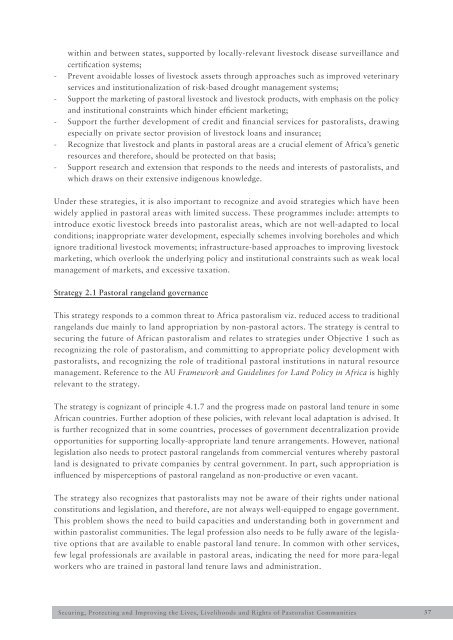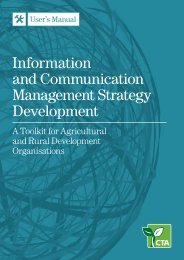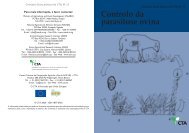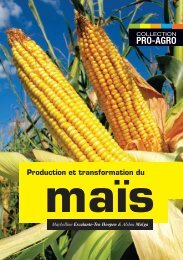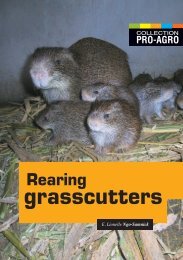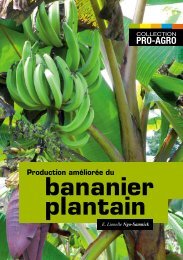Policy framework for Pastoralism in Africa
Policy framework for Pastoralism in Africa
Policy framework for Pastoralism in Africa
- No tags were found...
Create successful ePaper yourself
Turn your PDF publications into a flip-book with our unique Google optimized e-Paper software.
with<strong>in</strong> and between states, supported by locally-relevant livestock disease surveillance andcertification systems;--Prevent avoidable losses of livestock assets through approaches such as improved veter<strong>in</strong>aryservices and <strong>in</strong>stitutionalization of risk-based drought management systems;--Support the market<strong>in</strong>g of pastoral livestock and livestock products, with emphasis on the policyand <strong>in</strong>stitutional constra<strong>in</strong>ts which h<strong>in</strong>der efficient market<strong>in</strong>g;--Support the further development of credit and f<strong>in</strong>ancial services <strong>for</strong> pastoralists, draw<strong>in</strong>gespecially on private sector provision of livestock loans and <strong>in</strong>surance;--Recognize that livestock and plants <strong>in</strong> pastoral areas are a crucial element of <strong>Africa</strong>’s geneticresources and there<strong>for</strong>e, should be protected on that basis;--Support research and extension that responds to the needs and <strong>in</strong>terests of pastoralists, andwhich draws on their extensive <strong>in</strong>digenous knowledge.Under these strategies, it is also important to recognize and avoid strategies which have beenwidely applied <strong>in</strong> pastoral areas with limited success. These programmes <strong>in</strong>clude: attempts to<strong>in</strong>troduce exotic livestock breeds <strong>in</strong>to pastoralist areas, which are not well-adapted to localconditions; <strong>in</strong>appropriate water development, especially schemes <strong>in</strong>volv<strong>in</strong>g boreholes and whichignore traditional livestock movements; <strong>in</strong>frastructure-based approaches to improv<strong>in</strong>g livestockmarket<strong>in</strong>g, which overlook the underly<strong>in</strong>g policy and <strong>in</strong>stitutional constra<strong>in</strong>ts such as weak localmanagement of markets, and excessive taxation.Strategy 2.1 Pastoral rangeland governanceThis strategy responds to a common threat to <strong>Africa</strong> pastoralism viz. reduced access to traditionalrangelands due ma<strong>in</strong>ly to land appropriation by non-pastoral actors. The strategy is central tosecur<strong>in</strong>g the future of <strong>Africa</strong>n pastoralism and relates to strategies under Objective 1 such asrecogniz<strong>in</strong>g the role of pastoralism, and committ<strong>in</strong>g to appropriate policy development withpastoralists, and recogniz<strong>in</strong>g the role of traditional pastoral <strong>in</strong>stitutions <strong>in</strong> natural resourcemanagement. Reference to the AU Framework and Guidel<strong>in</strong>es <strong>for</strong> Land <strong>Policy</strong> <strong>in</strong> <strong>Africa</strong> is highlyrelevant to the strategy.The strategy is cognizant of pr<strong>in</strong>ciple 4.1.7 and the progress made on pastoral land tenure <strong>in</strong> some<strong>Africa</strong>n countries. Further adoption of these policies, with relevant local adaptation is advised. Itis further recognized that <strong>in</strong> some countries, processes of government decentralization provideopportunities <strong>for</strong> support<strong>in</strong>g locally-appropriate land tenure arrangements. However, nationallegislation also needs to protect pastoral rangelands from commercial ventures whereby pastoralland is designated to private companies by central government. In part, such appropriation is<strong>in</strong>fluenced by misperceptions of pastoral rangeland as non-productive or even vacant.The strategy also recognizes that pastoralists may not be aware of their rights under nationalconstitutions and legislation, and there<strong>for</strong>e, are not always well-equipped to engage government.This problem shows the need to build capacities and understand<strong>in</strong>g both <strong>in</strong> government andwith<strong>in</strong> pastoralist communities. The legal profession also needs to be fully aware of the legislativeoptions that are available to enable pastoral land tenure. In common with other services,few legal professionals are available <strong>in</strong> pastoral areas, <strong>in</strong>dicat<strong>in</strong>g the need <strong>for</strong> more para-legalworkers who are tra<strong>in</strong>ed <strong>in</strong> pastoral land tenure laws and adm<strong>in</strong>istration.Secur<strong>in</strong>g, Protect<strong>in</strong>g and Improv<strong>in</strong>g the Lives, Livelihoods and Rights of Pastoralist Communities37


